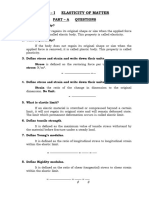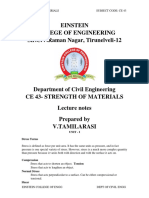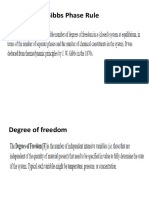Class 11 Physics ch-8 Notes
Class 11 Physics ch-8 Notes
Uploaded by
gonak24799Copyright:
Available Formats
Class 11 Physics ch-8 Notes
Class 11 Physics ch-8 Notes
Uploaded by
gonak24799Original Title
Copyright
Available Formats
Share this document
Did you find this document useful?
Is this content inappropriate?
Copyright:
Available Formats
Class 11 Physics ch-8 Notes
Class 11 Physics ch-8 Notes
Uploaded by
gonak24799Copyright:
Available Formats
These notes are provided by Studifysucess
Physics Class 11
Chapter 8
Mechanical Properties of Solid
Introduction
▪ A rigid body generally means a hard solid object having a definite shape and size.
▪ The property of a body, by virtue of which it tends to regain its original size and shape when the applied
force is removed, is known as elasticity and the deformation caused is known as elastic deformation.
▪ If you apply force to a lump of putty or mud, they have no gross tendency to regain their previous
shape, and they get permanently deformed. Such are called plastic and this property is called plasticity
Stress
▪ The Restoring force acting per unit area of a deformed body is called stress.
Stress = Restoring force / Area (N/m²)
▪ Stress is a tensor quantity.
Stress is of Two Types
(i) Tensile stress — longitudinal stress (associated with stretching) or compressive stress (associated with
compression)If there is a decrease in length, then stress is called compression stress.
(ii) Tangential Stress If deforming force is applied tangentially, then the stress is called tangential stress.
https://www.studifysuccess.com/ Made By - Ahad
These notes are provided by Studifysucess
Strain
▪ The fractional change in dimension is called strain.
Strain = Change in the configuration / Original configuration (no unit )
Strain is of three types
(1) Longitudinal strain= Change in length / Original length
(2) Volumetric strain = Change in volume / Original volume
(3) Shearing strain = Angular displacement of the plane perpendicular to the fixed surface.
S
Stress – Strain Curve
Hooke’s Law
▪ Within the limit of elasticity, the stress is proportional to the strain.
Stress = E * Strain
where, E is the modulus of elasticity of the material of the body.
https://www.studifysuccess.com/ Made By - Ahad
These notes are provided by Studifysucess
Types of Modulus of Elasticity
1. Young’s Modulus of Elasticity
▪ It is defined as the ratio of normal stress to the longitudinal strain Within the elastic limit.
y = Normal stress / Longitudinal strain
y = FΔl / Al = Mg Δl / πr2l (N/m²)
2. Bulk Modulus of Elasticity
▪ It is defined as the ratio of normal stress to the volumetric strain within the elastic limit.
K = Normal stress / Volumetric strain
K = FV / A ΔV = Δp V / Δ V (N/m2)
3. Modulus of Rigidity (η)
▪ It is defined as the ratio of tangential stress to the shearing strain, within the elastic limit.
η = Tangential stress / Shearing strain (N/m2)
Poisson’s Ratio
▪ When a deforming force is applied at the free end of a suspended wire of length 1 and radius R, then its
length increases by dl but its radius decreases by dR. produced by a single force.
(i) Longitudinal strain = Δ U l
(ii) Lateral strain = – Δ R/ R
Poisson’s Ratio (σ) = Lateral strain / Longitudinal strain = – Δ R/ R / ΔU l
▪ The theoretical value of Poisson’s ratio lies between – 1 and 0.5. Its practical value lies between 0 and
0.5.
https://www.studifysuccess.com/ Made By - Ahad
These notes are provided by Studifysucess
Elastic Potential Energy in a Stretched Wire
▪ When a wire is put under a tensile stress, work is done against the inter-atomic forces. This work is
stored in the wire in the form of elastic potential energy.
When a wire of original length L and area of cross-section A is subjected to a deforming force F along the
length of the wire, let the length of the wire be elongated by l. Then we have F = YA × (l/L). Here Y is the
Young’s modulus of the material of the wire.
This work is stored in the wire in the form of elastic potential energy (U). Therefore the elastic
potential energy per unit volume of the wire (u) is
u=½ σε
APPLICATIONS OF ELASTIC BEHAVIOUR OF MATERIALS
▪ While designing a building, the structural design of the columns, beams and supports require
knowledge of strength of materials used.
▪ Cranes used for lifting and moving heavy loads from one place to another have a thick metal rope to
which the load is attached. The rope is pulled up using pulleys and motors.
▪ A bridge has to be designed such that it can withstand the load of the flowing traffic, the force of winds
and its own weight. Similarly, in the design of buildings the use of beams and columns is very common
https://www.studifysuccess.com/ Made By - Ahad
You might also like
- Me-8395-Strength of Materials For Mechanical EngineersNo ratings yetMe-8395-Strength of Materials For Mechanical Engineers59 pages
- CBSE Class 11 Physics Chapter 9 Mechanical Properties of Solids Revision NotesNo ratings yetCBSE Class 11 Physics Chapter 9 Mechanical Properties of Solids Revision Notes43 pages
- Physics Notes Class 11 CHAPTER 9 MECHANICAL PROPERTIES OF SOLIDS PDFNo ratings yetPhysics Notes Class 11 CHAPTER 9 MECHANICAL PROPERTIES OF SOLIDS PDF7 pages
- Physics Notes Class 11 Chapter 9 Mechanical Properties of Solids100% (8)Physics Notes Class 11 Chapter 9 Mechanical Properties of Solids7 pages
- Department of Civil Engineering: Important DefinitionsNo ratings yetDepartment of Civil Engineering: Important Definitions7 pages
- Mechanical Properties of Engineering MaterialsNo ratings yetMechanical Properties of Engineering Materials26 pages
- Learncbse - In-Mechanical Properties of Solids Class 11 Notes Physics Chapter 9No ratings yetLearncbse - In-Mechanical Properties of Solids Class 11 Notes Physics Chapter 99 pages
- Mechanical Properties of Materials ClassNoteNo ratings yetMechanical Properties of Materials ClassNote9 pages
- MEC 2309 Lecture 14 - Mechanical Properties of Materials INo ratings yetMEC 2309 Lecture 14 - Mechanical Properties of Materials I78 pages
- Unit - 1 Elastic Properties of MaterialsNo ratings yetUnit - 1 Elastic Properties of Materials13 pages
- LTC4000 - High Voltage High Current Controller For Battery Charging and Power ManagementNo ratings yetLTC4000 - High Voltage High Current Controller For Battery Charging and Power Management13 pages
- Jumanji BXT Level Characters - Google SearchNo ratings yetJumanji BXT Level Characters - Google Search1 page
- The Art of Squishing Things Till They GiveNo ratings yetThe Art of Squishing Things Till They Give12 pages
- Oracle Business Intelligence Suite Enterprise Edition Plus (OBIEE Plus)No ratings yetOracle Business Intelligence Suite Enterprise Edition Plus (OBIEE Plus)2 pages
- RRB JE CBT-2 Electronics Tech Paper With Key 31-8-2019 1st ShiftNo ratings yetRRB JE CBT-2 Electronics Tech Paper With Key 31-8-2019 1st Shift55 pages
- Opti Cal Quick Guide System 1200 Format File Load To Data DownloadNo ratings yetOpti Cal Quick Guide System 1200 Format File Load To Data Download2 pages
- 2018 MY OBD S O S D E: Ystem Peration Ummary For Iesel Ngines100% (1)2018 MY OBD S O S D E: Ystem Peration Ummary For Iesel Ngines210 pages
- Coordinate Geometry Exercises and SolutionsNo ratings yetCoordinate Geometry Exercises and Solutions28 pages
- The Formation of Frosty Diamond Crystals in An Aqueous Solution of Aluminum Potassium SulfateNo ratings yetThe Formation of Frosty Diamond Crystals in An Aqueous Solution of Aluminum Potassium Sulfate1 page
- Me-8395-Strength of Materials For Mechanical EngineersMe-8395-Strength of Materials For Mechanical Engineers
- CBSE Class 11 Physics Chapter 9 Mechanical Properties of Solids Revision NotesCBSE Class 11 Physics Chapter 9 Mechanical Properties of Solids Revision Notes
- Physics Notes Class 11 CHAPTER 9 MECHANICAL PROPERTIES OF SOLIDS PDFPhysics Notes Class 11 CHAPTER 9 MECHANICAL PROPERTIES OF SOLIDS PDF
- Physics Notes Class 11 Chapter 9 Mechanical Properties of SolidsPhysics Notes Class 11 Chapter 9 Mechanical Properties of Solids
- Department of Civil Engineering: Important DefinitionsDepartment of Civil Engineering: Important Definitions
- Learncbse - In-Mechanical Properties of Solids Class 11 Notes Physics Chapter 9Learncbse - In-Mechanical Properties of Solids Class 11 Notes Physics Chapter 9
- MEC 2309 Lecture 14 - Mechanical Properties of Materials IMEC 2309 Lecture 14 - Mechanical Properties of Materials I
- LTC4000 - High Voltage High Current Controller For Battery Charging and Power ManagementLTC4000 - High Voltage High Current Controller For Battery Charging and Power Management
- Oracle Business Intelligence Suite Enterprise Edition Plus (OBIEE Plus)Oracle Business Intelligence Suite Enterprise Edition Plus (OBIEE Plus)
- RRB JE CBT-2 Electronics Tech Paper With Key 31-8-2019 1st ShiftRRB JE CBT-2 Electronics Tech Paper With Key 31-8-2019 1st Shift
- Opti Cal Quick Guide System 1200 Format File Load To Data DownloadOpti Cal Quick Guide System 1200 Format File Load To Data Download
- 2018 MY OBD S O S D E: Ystem Peration Ummary For Iesel Ngines2018 MY OBD S O S D E: Ystem Peration Ummary For Iesel Ngines
- The Formation of Frosty Diamond Crystals in An Aqueous Solution of Aluminum Potassium SulfateThe Formation of Frosty Diamond Crystals in An Aqueous Solution of Aluminum Potassium Sulfate
























































































